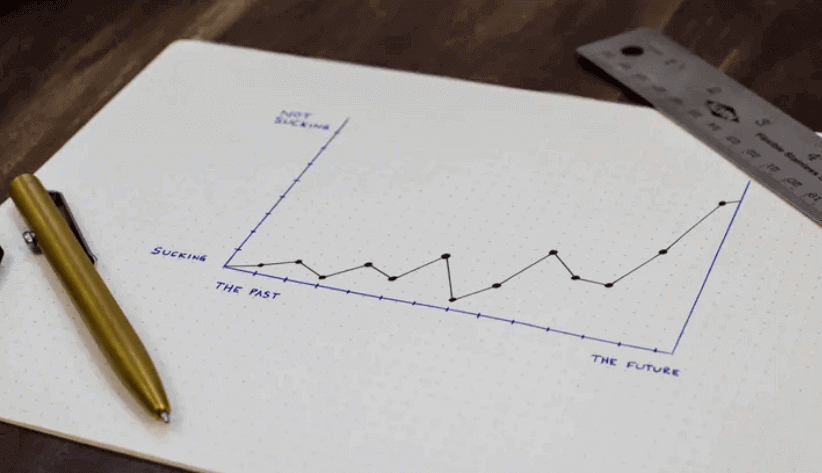In the current sluggish market, many products have slowed their progress. As product managers, we inevitably receive fewer demands in this situation. So, what can we do during such times?
We’re all aware of the current economic climate. Glance at industry news or talk to the people around you, and you'll get a sense of the challenges. Companies that manage to survive in such tough times are truly remarkable. That said, I don't want to spread anxiety here—because it doesn't help anyone.、

01. Return to the Essence of the Product
When we talk about returning to the essence of the product, we mean asking ourselves: what is the true value of our product?
If you can't explain your product in one sentence, then it likely lacks a strong sense of purpose. Every product should excel in a specific area and carve out its unique space. This is the essence of any product.
Take familiar examples like Google’s "Do the right thing," Amazon’s "Work hard. Have fun. Make history," Apple’s "Think different," Meta’s "Connecting the world," and TikTok’s "Inspire creativity and bring joy." These simple, straightforward, and memorable slogans define the core purpose of these products.
Of course, not every product can easily find its positioning. This requires deep thinking and refinement, and it’s not always easy to achieve.
Let me share a counterexample from a previous company I worked for, a classic startup mistake—trying to be everything for everyone, and as a result, doing nothing well.
Our company was developing data visualization software. Initially, we targeted large corporations, as smaller companies didn’t have the same need for customized data solutions. However, as development progressed, the target market kept shifting—from large companies to medium-to-large companies, and then to everyone. The final slogan became, “Let everyone create professional data reports.” The product's scope kept expanding, and in the end, it launched hurriedly and failed. It covered too many use cases and, ultimately, wasn’t useful for anyone.
When business is booming, it’s easy to overlook this. Everyone’s busy with growth, and no one wants to pause to reflect on these seemingly insignificant issues.
But when business slows down, and fewer demands are coming in, that’s precisely the time to reflect on the essence of the product.
02. Return to the Core Use Case
When we return to the core use case, we ask: who is our product serving? What convenience does it provide? What problems does it solve? What value does it bring?
This is actually easier to summarize than the product’s essence because it's tied to user personas, something we consider during the design phase.
Behind every demand lies a standard process. According to Youzan’s standards, to meet a demand, we need to know what problem the user is facing in what context and how they will solve it.
By deeply understanding our users, we can better step into their shoes and design features that fit their needs.
Here are two examples from my own work experience:
The first example involves a product designed for appliance repair technicians, similar to the ride-hailing apps we know today, but for appliance repair. We were pushing this order-grabbing feature, where technicians could see repair requests and respond. However, when the feature launched, it lacked voice notifications. We envisioned the scenario where technicians would be at home, check their phones for new orders, and click to accept them.
But shortly after launching, we received feedback from many technicians asking for voice notifications. After deeper investigation, we realized most technicians were out in the field, often performing tasks like high-altitude repairs. They couldn’t stop to check their phones, so they needed voice alerts to decide whether to grab an order. They also requested larger buttons for easier interaction, as our original buttons were designed to mimic e-commerce platforms.
The second example involved a management tool for indoor swimming pools, primarily used on PCs. We added a feature that would notify staff via a voice alert when a VIP entered, with the audio coming from a turnstile speaker (similar to those in subway stations). Shortly after launch, pool staff asked for a pop-up notification on their PCs, as they couldn’t hear the turnstile speaker due to the noisy environment. We learned that they constantly monitored the screen for order updates, which could be confusing when things got busy. So, they wanted VIP entry notifications to be more visible on their computers, not just in the order list.
These examples illustrate that the scenarios we imagine in the office can be completely different from real-world situations. Without diving deep into the business, it's hard to understand these seemingly illogical requests.
Of course, during busy times, we can overlook some of these issues. But when things slow down, shouldn’t we get closer to the business and understand these core use cases?
03. Return to Your Own Essence
Finally, this point is more about introspection than work itself.
There’s a saying: "Busy, busy, busy—until in the end, it all amounts to nothing." Product managers often experience this.
Our job tends to be busy by nature—busy in terms of both time and energy.
If we compare our product to a necklace, then as product managers, we are the string holding everything together. Without the string, nothing works. But no one notices it. It’s this string that connects every role—projects, business, design, development, operations. So, is it tiring? Of course. You have to manage everything without actually making the decisions, and everyone is relying on you.
Someone once said that project managers spend 80% of their energy on communication. I think the same applies to product managers. We spend every day in various meetings, confirmations, and dilemmas.
The role of a product manager is, in many ways, like "Schrödinger's cat." If you think it has meaning, then you’ll end up taking the blame. If you think it doesn’t have meaning, then it really doesn't hold much value. Think about it—if your department had to cut one role, which one do you think would be the first to go?
So, with all this pessimism, what’s the point of sticking with it? That’s something we have to figure out for ourselves. Is this job something we truly love from the bottom of our hearts, or is it just something we do to get by? I believe everyone has their own answer, but everyone also has their own struggles.
Given this, perhaps it’s best not to overthink things. Focus on the task at hand and make peace with yourself. Maybe this is our way of returning to our essence.
Follow your heart’s true desires, and avoid future regret. If you can do that, maybe it’s enough.
Some Final Thoughts
Keep pushing forward. Things will get better!







